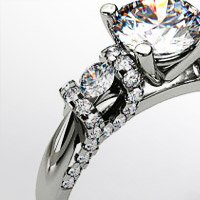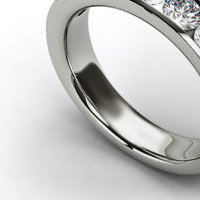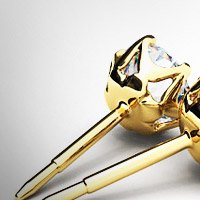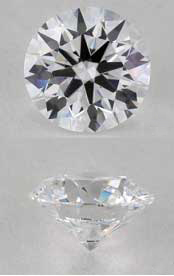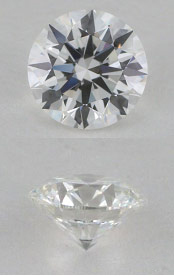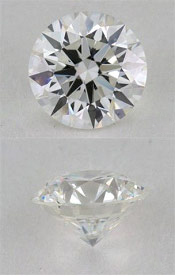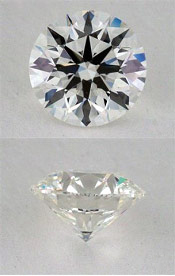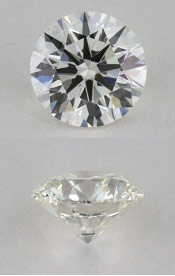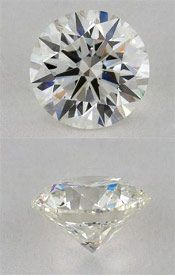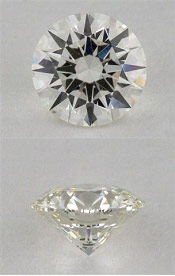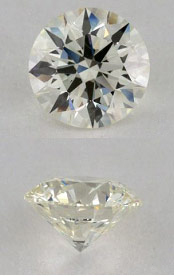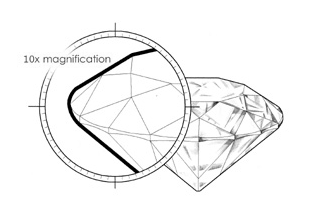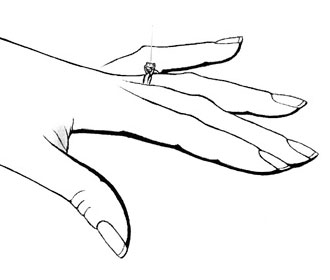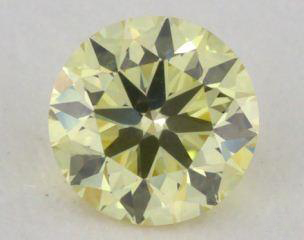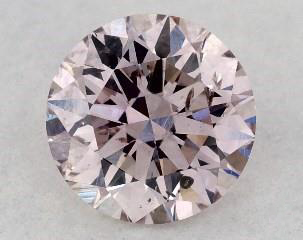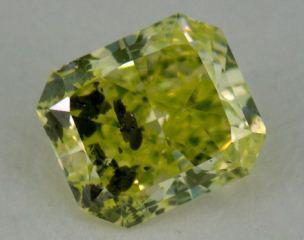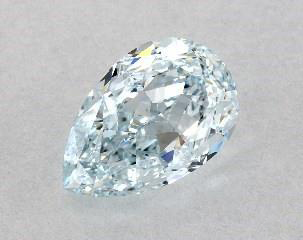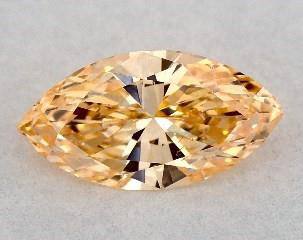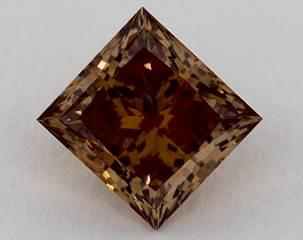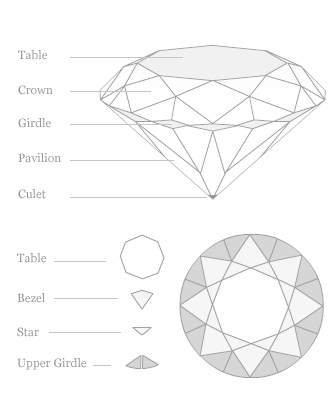
Diamond Cut
The cut of a diamond not only refers to the diamond’s shape, it also refers to how effectively the diamond returns light back to the viewer’s eye. A well-cut diamond will appear very brilliant and fiery, while a poorly cut diamond can appear dark and lifeless, regardless of its color or clarity.
Not only do well-cut diamonds appear more brilliant, they also tend to appear larger than other diamonds of the same carat weight. An "ideal" diamond has both increased brilliance and diameter relative to more deeply-cut diamonds.
Ideal cut diamonds
An Ideal Cut Diamond is a round, brilliant, or princess cut diamond that is cut to ideal proportions and angles, and has excellent polish and symmetry ratings. An Ideal Cut Diamond is perfectly proportioned to refract light, producing that fire and brilliance up through to the table and crown. Skc Jewelry offers a nice selection of Ideal Cut Diamonds know at True HeartsTM
Hearts and Arrows True HeartsTM
Seen from above, a Hearts and Arrows diamond shows an arrow pattern. When displayed on its pavilion side, the diamond presents the eye with 8 hearts with tiny 'v' shapes. Genuine Hearts and Arrows have these patterns visible at a single glance, indicating that the diamond has perfect optical symmetry.
Our Hearts and Arrows collection are the ultimate expression of love - that's why we call them TrueHeartsTM. Every diamond from our TrueHeartsTM collection is a lasting masterpiece, a perfect diamond.
Hearts and Arrows diamonds are sold under many names - Hearts on Fire and Leo Diamonds are two popular examples. At Skc Jewelry, we take pride in presenting only the finest Hearts and Arrows diamonds money can buy - every single TrueHeartsTM diamond we sell is cut and polished at 100X magnification. Furthermore, our exclusive Diamond Display TechnologyTM lets you see any True HeartsTM diamond magnified in 360° so you can see exactly what you are getting.
Understanding Brilliance, Dispersion & Scintillation
A well-cut diamonds exhibit three different properties: brilliance, dispersion and scintillation. As light strikes a diamond's surface, it will either reflect off the table of a polished stone or enter the diamond. The light that is reflected off the diamond is known as the diamond's brilliance. As light travels through a stone, some of the light rays are separated into flashes of color. This is known as dispersion. The result of dispersion—the separation of white light into its spectral colors— is known as fire. Scintillation is flashes of color that are viewable as an observer moves a diamond back and forth.
Diamond Color
When shopping for a diamond, it is generally preferred to choose a stone with the least amount of color possible. Diamond color is graded on a scale from D-Z and is divided into five broad categories (colorless, near colorless, faint, very light and light). Diamonds come in all colors of the spectrum. The predominant color you see in a diamond is yellow, which is caused by the trace element nitrogen.
Generally, when comparing color between two diamonds, the diamonds need to be at least two color grades apart to even begin to see a difference. As you can see from the images below, when diamonds are in the face up position it is almost impossible to see any color. When viewing the diamond from the side profile, you may start to detect some color; however, diamonds are admired for their beauty from the face up position and not the side.
Colorless Diamonds (D-F):
Diamonds within the colorless range are the most rare and valuable of all those on the color scale. D/E color stones display virtually no color, whereas F colored diamonds will display a nearly undetected amount of color when viewed face down by a gemologist.
Near Colorless Diamonds (G-J):
Diamonds within the near colorless range appear colorless in the face up position, but do display a slight amount of color when viewed face down against a perfectly white background. This trace amount of color will be undetectable to an untrained eye once the diamond has been mounted. Near colorless diamonds offer a tremendous value for their price.
Faint Color Diamonds (K):
Diamonds within the faint color category may show a slight hint color when viewed in the face up position; however, these are another wonderful option for those who are not sensitive to color. Some even love the color scheme that is displayed from these diamonds.
While the most predominant color found in a diamond is yellow, it’s not uncommon for a diamond to take on a brown color. This is thought to be caused by internal graining, which results from structural irregularities often in combination with an impurity like nitrogen.
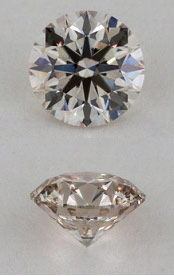
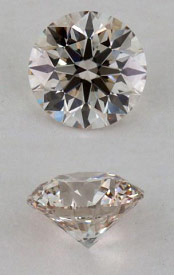
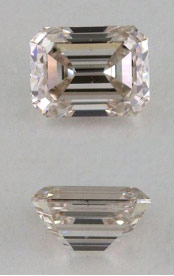
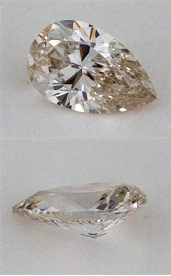
Diamond Clarity
Which Clarity Grade to Choose?
It is important to select a diamond that does not have any inclusions that will affect the overall beauty and durability of the diamond. If you want to be 100% sure that your diamond will be completely clean of "eye-visible" inclusions, stick with diamonds graded "VS2" or higher. Shopping for SI quality diamonds can be very rewarding, but it's best to have those diamonds reviewed by skc jewelry’s expert staff before finalizing your order. This will ensure you receive a diamond that does not have any inclusions visible to the naked eye.
It is also a good idea to balance the clarity grade of your diamond with the color. If you are looking at diamonds in the D-F color range, focus on clarity grades of VS2 or higher. Diamonds in the G-I color range combined with SI clarity are excellent values.
Diamond Weight
Carat is a term that refers to the weight of a diamond. Prior to the twentieth century, diamonds were measured using carob seeds, which were small and uniform and served as a perfect counter weight to the diamond. The word "carob” is the origin of the word "carat" that we use today.
Diamond Size and Diamond Carat Weight
The size of a diamond is proportional to its carat weight. When rough diamonds are cut and polished into finished diamonds, up to 2/3 of the total carat weight may be lost. Since larger rough gems of high quality are found less frequently than smaller rough gems of high quality, a single two carat diamond will be more expensive than two one-carat diamonds of the same quality.
In the United States, the majority of diamonds used in jewelry and sold as loose diamonds are one carat or less in weight. The average engagement ring diamond sold in the U.S. is less than 1/2 carat in weight.
A diamond will increase in weight much faster than it increases in actual "face-up" diameter. For example, while an ideal cut one-carat diamond measures approximately 6.5mm in width, a diamond of twice its weight measures only 8.2mm wide—less than a 30% increase. The graphic to the left helps illustrate this point.
Which Carat Weight Is Right For You?
This question has no direct answer. It is a choice that depends on personal preference and budget. When looking at a diamond engagement ring, what is most visible is the size of the surface area on the top of the diamond. It is difficult to measure a diamond’s carat weight simply by looking at it. Although carat weight influences cost quite a bit, it is advisable to focus on diamond cut and diameter.

Diamond Shapes
Diamonds come in many different shapes. Each diamond shape possesses its own unique qualities, so exploring and learning about the various shapes is worth your while. skc jewelry offers the highest quality certified diamonds to satisfy all tastes.
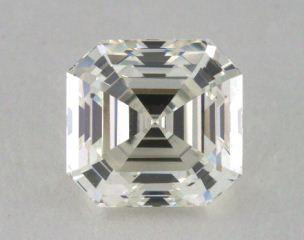
Asscher Cut Diamonds
The Asscher Cut Diamond, also called a "Square Emerald-Cut", is made using a step-cut process and has cropped corners. Because of the cropped corners, an Asscher Cut Diamond appears almost octagonal at first glance. They are bright, shiny, and clear in appearance. Like Emerald-Cut Diamonds, they have the clarity of glacier-water ice, allowing you to see all the way through the stone. However, since inclusions are obvious to the naked eye with Asscher Cut Diamonds, it is important to get one that is flawless or as close to flawless as possible.
SHOP ASSCHER CUT DIAMONDS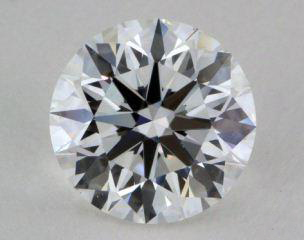
Brilliant Cut Diamonds
The Round Diamond, or Brilliant Cut Diamond, is by far the most popular shape for diamond engagement rings. It is cone-shaped to maximize light return through the top of the diamond. It is cut to have 58 facets: 33 on the crown and 25 on the pavilion. The relationship between the angle of the crown (above the girdle) and the pavilion (below the girdle) is complementary. A steep crown angle is complemented by a shallower pavilion angle, and vice versa.
SHOP BRILLIANT CUT DIAMONDS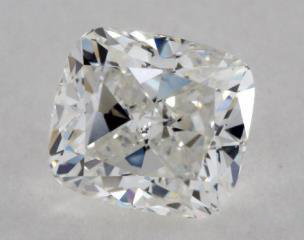
Cushion Cut Diamonds
The Cushion Cut Diamond is an antique cut that has a classic, romantic appeal. It is considered a cross between the Old Mine Cut, which was popular in the late 19th and early 20th centuries, and a modern Oval-Cut Diamond. The Old Mine Cut featured large facets and rounded corners, since the cutting was all done by hand at the time. They were designed to catch the beauty of candlelight. The Cushion-Cut Diamond contains 58 facets.
SHOP CUSHION CUT DIAMONDS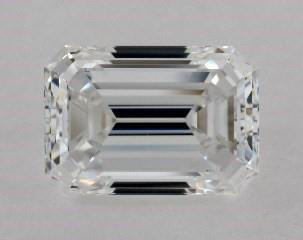
Emerald Cut Diamonds
The Emerald-Cut Diamond is a very popular style known for its beauty and precision. While it lacks the brilliance of diamonds cut with triangular and kite-shaped facets, it more than makes up for it in its extreme clarity – it’s like looking into glacier-pure ice. The Emerald-Cut diamond is named so because this style of cut was originally used only on emeralds. It is called a step-cut, which is the cut most commonly used on square or rectangular diamonds.
SHOP EMERALD CUT DIAMONDS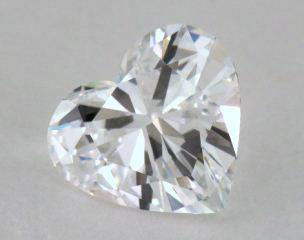
Heart Diamonds
The Heart Shaped Diamond has a cleft at the top and exhibits superior brilliance. It is among the most romantic of the diamond shapes. When selecting a heart shaped diamond, symmetry is essential, as the two halves of the heart must be identical. The split between the two lobes should be obvious and sharp, and the wings should have a round shape. Generally, heart shapes diamonds of less than .50 carats are not a good choice. As opposed to other diamond shapes, they appear smaller, especially after set in prongs. Bezel and three prong settings are best for small heart shaped diamonds.
SHOP HEART SHAPE DIAMONDS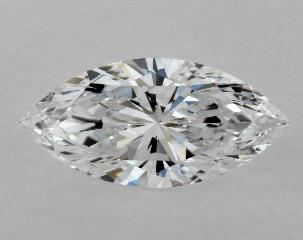
Marquise Diamonds
The Marquise-Cut Diamond is a boat-shaped brilliant stone that is considered to be a "classic" shape for diamond engagement rings. As with all 'fancy cut' diamonds, color and clarity are the two most important qualities in this particular style of cut. The Marquise-Cut Diamond uses a cutting process similar to that of a Round Brilliant Diamond, but the diamond cutter maximizes the carat weight of the gem by elongating it into its distinctive ''boat-shape''. This way, they can eliminate all inclusions while maintaining as much of the unblemished stone as possible. However, because of the elongated shape, color and clarity imperfections are more obvious than they are in a traditional Round Brilliant Diamonds.
SHOP MARQUISE CUT DIAMONDS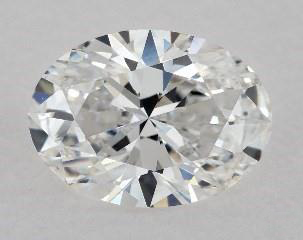
Oval Diamonds
The Oval Cut Diamond is a modified version of the most popular cut, the Round Brilliant. It is the perfect choice for buyers who are looking for characteristics similar to the Round "Ideal" Cut, but would like something in a shape that is more unusual. Oval Cut diamonds also create the optical illusion of length and serve to elegantly elongate fingers.
SHOP OVAL CUT DIAMONDS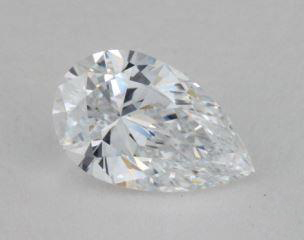
Pear Diamonds
The Pear Shaped Diamond combines the tradition and brilliance of a round cut with a less common shape to create an unusual diamond that can still make light 'dance' as it does in the traditional Round Brilliant Cut. It is probably the most subjective diamond shape, as its size and proportions are really a matter of taste. The diamond usually contains 58 facets, allowing for light to pass through it much the same way as in a Round, but makes more of an impression because of its much less common shape.
SHOP PEAR SHAPE DIAMONDS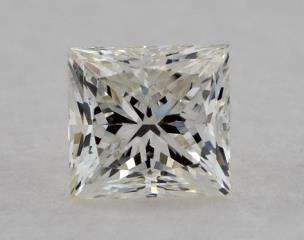
Princess Cut Diamonds
The Princess cut diamonds can make the perfect engagement rings since they are very clear. Their exquisite shape makes them an exotic treasure, as they are designed for getting top brilliance from their square cut. When purchasing a Princess Cut diamond, make sure that the setting for your ring protects the four pointed corners. The Princess Cut diamond allows more acceptably for flaws.
SHOP PRINCESS CUT DIAMONDS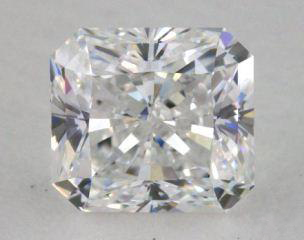
Radiant Cut Diamonds
The Radiant Cut Diamond combines the more stylish square or rectangular shape with the brilliance of the more traditional Round Cut. It combines two diamond cutting styles-the Round Cut style and the Emerald Cut style, to create a non-traditional, yet still brilliant, diamond. This cut, created in 1977 by Henry Grossbard, was designed to maintain the beauty of each different type of diamond, while still creating something altogether different from anything available at the time.
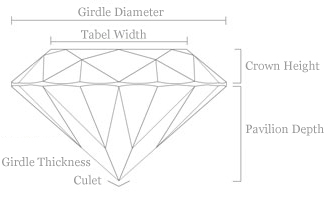
Diamond Anatomy
While every diamond is unique, all diamonds share certain structural features. A diamond’s anatomy, or its basic structure, determines its proportions, brilliance, dispersion and scintillation. Each part of the diamond has a specific name, and having a basic understanding of how each part contributes to the diamond as a whole will help you find your perfect diamond.
A diamond is comprised of the eight main components. They are Diameter, Table, Crown, Table Spread, Girdle, Pavilion, Depth, and Culet. Below is a brief description of each part of a diamond and its location.
- Diameter: The width of a polished stone, measured from edge to edge.
- Table: The largest polished facet located on the top of the diamond.
- Crown: The top part of a diamond extending from the table to the girdle. The crown is made up of bezel facets (crown mains), star facets, upper girdle facets (upper halves), and a table facet.
- Girdle: The very edge (widest edge) of the diamond where the crown and pavilion meet.
- Pavilion: The bottom part of a diamond extending from the girdle down to the culet.
- Depth: The total height of a diamond measured from the table to the culet.
- Culet: The small or pointed facet at the very bottom of the diamond.
Before purchasing a diamond, make sure that you have a basic understanding of a diamond’s anatomy. This will allow you to truly appreciate diamonds and all their intricacies, communicate with experts about a particular diamond, and, most importantly, it will assist you in making a well-thought out decision about which diamond is best for you.
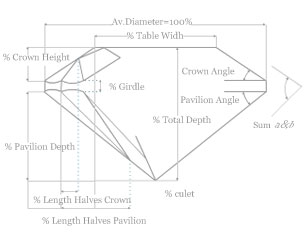
Proportion – Understanding Brilliance, Dispersion & Scintillation
Well–proportioned diamonds exhibit three different properties: brilliance, dispersion and scintillation. As light strikes a diamond's surface, it will either reflect off the table of a polished stone or enter the diamond. The light that is reflected is known as the diamond's brilliance — the flash of white light one sees when looking at a stone. As light travels through a stone, some of the light rays are separated into flashes of color. This is known as dispersion. The result of dispersion—the separation of white light into its spectral colors — is known as fire. Scintillation is flashes of color that are viewable as an observer moves a diamond back and forth.
Putting It All Together
Use this interactive tool to see how depth and table percentages can affect the brilliance in a round diamond. Please Note: this example is for a round diamond only—fancy shapes have their own set of unique properties.

Diamond Symmetry
Symmetry refers to the exactness of the shape and arrangement of facets in a diamond. Although to the naked eye finish features only have a tiny effect on appearance, symmetry is significant. In diamonds that have low clarity grades, symmetry is less important, but in diamonds with very high clarity grades, symmetry is very important.

Wavy Girdle
The girdle of a diamond should be a flat plane, parallel to the table. In this example the girdle "waves" as it wraps around the diamond.

Crown & Pavilion Misalignment
In a round diamond the top points of the pavilion mains and the bottom points of the bezel facets should meet precisely at the girdle. We can see in this example the diamond's crown and pavilion facets are misaligned.
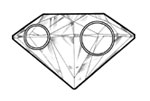
Extra Facets
These are typically located on the pavilion, near the girdle, but they can be found anywhere on a diamond. In this example we see where extra facets commonly occur.
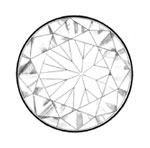
Off-Center Culet
To check if the culet is centered, look at the diamond in the face-up position. You'll see the lower girdle facets through the table. If the lines formed by them look like a perfect square, the culet is centered. If the cross bends one way of the other, the culet is not centered. In this example we see what an off-centered culet might look like.
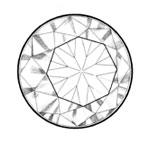
Off-Center Table
The placement of the table (the largest facet on a diamond) should be centered at the top of the stone and needs to be parallel to the girdle. If the table is off-center or not parallel with the girdle this can cause uneven crown angles from one side to the other. In this example we see the unbalanced appearance that occurs from an off-center table.
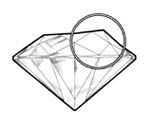
Table & Girdle Not Parallel
Here we see another example of what occurs when the table is not parallel with the girdle. As you see, the crown angle is much steeper on one-side than the other. From the top view you may have noticed an off-center table.
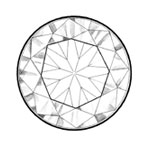
Misshapen Face
A correct table displays a regular octagon shape. It should have eight sides of equal length that are each parallel to the opposing opposite facet. In this example we see facets that are not properly shaped, or they are not the same size and shape as others like them on the face of the diamond.
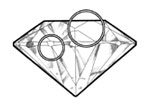
Faces Not Pointing Up
Some diamonds display facets that are not properly pointed. Facet patterns of round brilliants are meant to show a precise arrangement of 58 perfectly shaped facets. In this example we see some that some do not meet at a direct point.
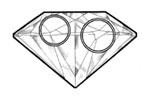
Naturals on Crown and Pavilion
A natural is the original "rough" of the diamond. Naturals always occur or start out on the girdle. They either dip towards the pavilion or the crown. In this example we see the natural located on the girdle running down into the pavilion.
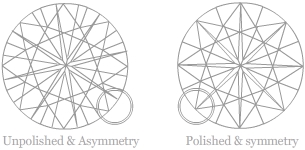
Diamond Polish
What Is Diamond Polish?
Diamond polish influences how well light is able to pass through a diamond. It is a very important attribute in determining a diamond's overall brilliance. When choosing a diamond, it is best to pick one that is laboratory certified with good, very good or excellent polish. Diamonds with poor polish are significantly less brilliant because they have microscopic polish lines that blur the surface of the stone—this also reduces the amount of light that enters or exits the diamond. Be aware that many diamonds have a poor polish because some diamond cutters reduce their costs by not spending sufficient time to properly polish a diamond.
How Is Polish Graded?
Polish is graded the same that way symmetry is graded. On a GIA report, the grades are Excellent, Very Good, Good, Fair or Poor. The same applies for AGS and IGI reports, which also include ideal in their list.
- EX or E - Excellent, Flawless at 10X magnification
- VG or VGD - Very Good, Extremely difficult to locate under 10X magnification
- GD, GO, G - Good, Very difficult to see under 10X magnification
- F, FR, FA - Fair, Noticeable under 10X magnification
- PR, PO, P - Poor, Easy to see under 10X magnification / Visible to unaided eye
- VP, VE - Very Poor, Relatively easy to see with the unaided eye
- EX or EP - Extremely Poor, Obvious to see with unaided eye
There is very little difference between these ratings to the unaided eye. A diamond with a polish rating of Good can still be a remarkable stone. It is only under magnification that the differences in these ratings become clearer. Polish rated Fair (FR) and Poor (PR), however, indicates that the flaws in the polish are visible to the naked eye and affect the overall beauty of the diamond.
It is also important that your ring does not have a porosity problem or rough spots in the metal. Porosity is when there are little surface holes that get worse as you go deeper into the metal. Generally the result of mass producing rings with poor quality control, porosity makes a ring weak and is non-repairable. A ring with porosity will eventually break down.
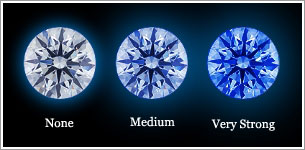
Fluorescence
What Is Diamond Fluorescence?
Fluorescence is a naturally occurring phenomenon that appears in certain minerals and gems. Some quality diamonds display a visible light when they are exposed to ultraviolet light. This light is known as fluorescence. Under most lighting conditions, a diamond's fluorescence is not visible to the naked eye, although the diamond will exhibit a soft colored glow if held under an ultraviolet lamp.
Do All Diamond Fluoresce?
Not all diamond fluoresce. If a specific diamond does not fluoresce, the grading report will list the diamond's fluorescence as either inert or none.
What Are The Different Types of Diamond Fluorescence?
The degree of fluorescence varies from faint to medium to strong to very strong. Faint means that the stone has a slight glow that is difficult to see under ultraviolet light. Very strong means that the diamond emits a deep glow that is very clear under ultraviolet light. The color of the fluorescence can also vary, although blue is the most common color. Yellow, green and white are other colors that a fluorescent diamond may exhibit.
How Does Fluorescence Affect A Diamond?
Fluorescence usually has no effect on a diamond's appearance in regular lighting conditions. In some cases, however, a strong blue fluorescence can make a yellow colored diamond appear whiter. In rare cases, it can or cause a stone to appear milky or oily.
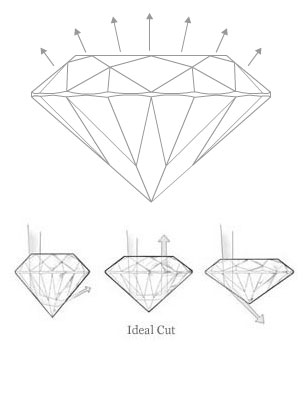
Ideal Cut Diamonds
An ideal cut diamond is a round, brilliant, or princess cut diamond that is cut to ideal proportions and angles and has excellent polish and symmetry ratings. An ideal cut diamond reflects almost all the light that enters it, and is among the rarest cuts. The ideal cut diamond is used as benchmark for grading all other diamonds. In America, ideal cut proportions are often determined by the American Gem Society Laboratory (AGSL), but different countries and different companies base their idea of the ideal cut on different standards.
Back in the 1900s, Belgian diamond cutter, Marcel Tolkowsky, coined the term- Ideal Cut. After analyzing the round brilliant cut diamond, he took both brilliance (the amount of the white light reflected) and fire (the separation of white light into its spectral colors) into consideration. While his calculations serve as a guide for today's idea of the global "ideal cut" standards, countries have still made their own modifications.
Tolkowsky's ideal cut is not perfect, but it nevertheless serves as a basic guideline for ideal cut diamonds. Today, we also use the guidelines of a gemstone cutter named Bruce Harding who developed another model in the 1970s as well as other computer models and technological scopes.
Ideal diamonds are perfectly proportioned to refract light, producing that fire and brilliance up through to the table and crown. There are at least six "ideal cuts" being used today but only three of them (including the one by Tolkowsky ) are the most common. skc jewelry, the premier diamond retailer, offers four cuts of diamonds, two of which are ideal. A TrueHearts diamond is a type of ideal cut diamond.
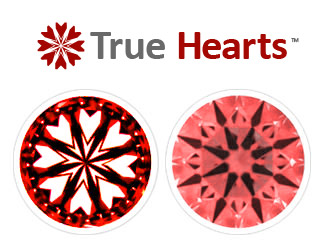
True Hearts by skc jewelryTM
True Hearts by skc jewelryTM is our premier collection of ideal cut diamonds, available in round cut (Hearts and Arrows diamonds), princess cut, and cushion cut.
True HeartsTM Round Cut (Hearts and Arrows Diamonds)
At the heart of our True HeartsTM collection are round cut diamonds. These superior Hearts and Arrows diamonds feature perfect proportions and symmetry, as well as the highest grades for cut and polish. When viewed from certain angles, they reveal intricate patterns of hearts and arrows. The stones are polished with great precision, yielding an internal reflection of arrows when viewed from above and hearts when viewed from below. This effect is incredibly hard to achieve for even the most skilled diamond cutters.
All True HeartsTM round cut diamonds on skc jewelry.com are displayed alongside actual images of their unique hearts and arrows patterns. These red and white ‘Ideal Scope’ images also serve as a clear indication of a diamond’s perfect optical symmetry.
A certificate from one of the world’s top grading laboratories – the GIA or AGS – accompanies each Hearts and Arrows diamond, verifying its superior quality. This document contains information about a diamond’s cut, polish, and symmetry, among other important attributes.
True HeartsTM Princess and Cushion Cut
For a princess cut or cushion cut diamond to qualify as a True HeartsTM diamond, it must be certified as an Ideal Cut by the AGS. This involves measuring a stone’s light performance - that is, how it reflects and bends the light to produce brilliance - as well as other characteristics such as cut, polish, and symmetry. All True HeartsTM princess cut and cushion cut diamonds on skc jewelry.com come with an AGS-certified Platinum Light Performance Diamond Quality Document.
Fewer than 1% of the world’s diamonds have the perfect internal symmetry and proportions necessary to earn the True HeartsTM distinction.
What is a True HeartsTM Lab-Created Diamond?
True HeartsTM lab-created diamonds contain the same internal symmetry and proportions as well as the highest gem grading for cut and polish found in True HeartsTM earth-created diamonds. The only difference between the two is their origin.
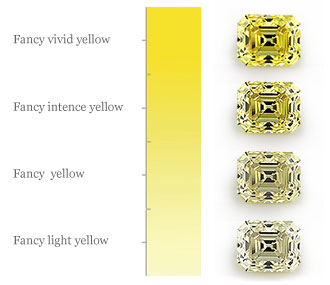
Color & Intensity
There are three different criteria used to determine a fancy color diamond’s color and intensity:
- The diamond’s primary color (i.e. pink)
- The diamond’s secondary color (i.e. purplish)
- The intensity of the diamond’s color (i.e. fancy, fancy intense, fancy vivid)
The primary and secondary colors determine the tone of the diamond’s color. The strength of the color is defined by its level of intensity. As a general rule of thumb, a fancy color diamond becomes more valuable as the color intensity increases. The classifications for fancy color diamonds are as follows: faint, very light, light, fancy light, fancy, fancy intense, fancy vivid/fancy deep/fancy dark.
Fancy Yellow
Yellow diamonds (also known as canary diamonds) are the most well-known of all fancy diamonds. Although many white diamonds appear yellow and are listed on the far end (Y-Z) of the standard diamond color scale, they are not considered fancy yellow diamonds.
A yellow diamond is considered fancy when it is graded according to the terms: light yellow, fancy light yellow, fancy yellow, fancy intense yellow, fancy dark yellow, fancy deep yellow, and fancy vivid yellow. True fancy yellow diamonds have a strong vivid color, and are generally more expensive per carat due to their rare beauty.
Roughly 60% of all fancy color diamonds are yellow diamonds. Yellow diamonds contain nitrogen, which is responsible for giving the diamond its yellow color.
skc jewelry offers a wide selection of fancy yellow diamonds, in a variety of shapes and carat sizes. Yellow diamonds are a great option when looking to add to your diamond selection and appear especially striking when set in a platinum or white gold setting.
Click here to view skc jewelry’s complete collection of natural fancy yellow diamonds.
Fancy Pink
Pink diamonds are some of the most alluring fancy diamonds on the market. Due to their extreme rarity, pink diamonds are some of the most valuable stones that you can buy. Pink diamonds can contain any of the following hues: very light pink, light pink, fancy light pink, fancy pink, fancy intense pink, fancy vivid pink, fancy deep pink.
Unlike other fancy color diamonds, it is unclear what exactly causes pink diamonds to exhibit pink hues. Though the exact cause is still a mystery, some scientists theorize that it is due to an atomic-level lattice defect, which selectively absorbs light and produces a pink hue.
Very saturated pinks and purplish pinks are incredibly rare and often used as collectors’ items. When a rare vivid pink or purplish pink is released to the market for purchase, it can easily reach millions of dollars per carat.
skc jewelry offers a wide selection of fancy pink diamonds, in a variety of shapes and carat sizes. Pink diamonds are a great option when looking to add to your diamond selection and appear especially striking when set in a platinum or white gold setting.
Argyle Pink Diamonds
The Argyle Diamond Mine is a diamond mine located in Western Australia, in the remote north. The Argyle Mine is the largest diamond producer in the world as measured by volume. It is also the only known significant source of rare pink diamonds, and produces over 90% of the world’s supply. Furthermore, the Argyle Mine produces a large amount of other naturally colored diamonds, including blue diamonds, cognac diamonds and champagne diamonds.
Some of our naturally fancy color diamonds come from the Argyle Mine in Australia. Every Argyle Mine Diamond comes with an authentic grading certificate.
Click here to view skc jewelry’s complete collection of natural fancy pink diamonds.
Fancy Green
Fancy green diamonds are the second rarest fancy color diamonds, after red diamonds. Since green is a mixture of blue and yellow, green colored diamonds commonly range from blue-green to yellow-green. Some fancy green diamonds can also display hints of grey or brown as well. Green diamonds that exhibit no traces of other colors are incredibly rare and valuable.
The grading scale for green diamonds is as follows: faint green, very light green, light green, fancy light green, fancy green, fancy intense green, fancy dark green, fancy deep green, and fancy vivid green.
A green diamond is formed over millions of years, after it has been infused with beta and gamma rays, which contributes to the diamond’s green hue. In some cases, the green diamond’s color exists only on the surface, which means that over time, the color will fade. Therefore, pure green diamonds are few and far between.
skc jewelry offers a variety of fancy green diamonds, in all shapes and carat sizes. Green diamonds are a great option when looking to add to your diamond selection and appear especially striking when set in a platinum or white gold setting.
Click here to view skc jewelry’s complete collection of GIA certified fancy green diamonds.
Fancy Blue
Fancy blue diamonds are among some of the rarest colored diamonds and therefore most valuable. The diamonds range in color from light blue to dark blue. The color breakdown for blue diamonds is as follows: faint blue, very light blue, light blue, fancy light blue, fancy blue, fancy intense blue, fancy dark blue, fancy deep blue and fancy vivid blue.
Other blue diamonds exhibit traces of green or grey. There are a variety of elements that give blue diamonds their distinctive tint. The primary element is boron, followed by hydrogen and nitrogen. Perhaps the most famous fancy blue diamond in the world is the Hope Diamond, which weighs over 45 carats.
Blue diamonds are created when the chemical boron becomes trapped in the diamond’s matrix. Blue diamonds usually contain negligible nitrogen impurities.
skc jewelry offers a variety of fancy blue diamonds, in all shapes and carat sizes. Blue diamonds are a great option when looking to add to your diamond selection and appear especially striking when set in a platinum or white gold setting.
Click here to view skc jewelry’s complete collection of natural fancy blue diamonds.
Fancy Orange
Orange diamonds often contain brown, yellow or pink overtones and hues. Fancy orange diamonds typically come from the Argyle mine in Australia, or from South Africa. Orange diamonds are mostly graded as fancy orange, fancy intense orange, fancy vivid orange, fancy deep orange and fancy dark orange.
In order for a diamond to be considered orange, it must contain no traces of brown, which is extremely rare. Because true orange diamonds are so rare, less is known about them than other fancy color diamonds, like pink or yellow.
skc jewelry offers a wide variety of fancy orange diamonds, in many shapes and carat sizes. Orange diamonds are a great option when looking to add to your diamond selection and appear especially striking when set in a platinum or white gold setting.
Click here to view skc jewelry’s complete collection of natural fancy orange diamonds.
Fancy Brown
Fancy brown diamonds make a nice alternative from the standard white diamond. Brown diamonds receive their color from a change in the diamond’s molecular structure. Light brown diamonds are known as champagne diamonds and brown diamonds that contain hues of orange are known as cognac diamonds.
skc jewelry offers a wide variety of fancy brown diamonds, in many shapes and carat sizes. Brown diamonds are a great option when looking to add to your diamond selection and appear especially striking when set in a yellow gold setting.
Click here to view skc jewelry’s complete collection of natural fancy brown diamonds.
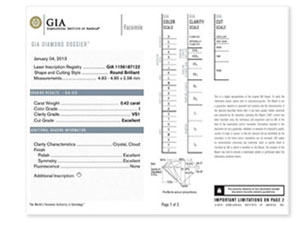
What is a Diamond Certificate?
A diamond certificate verifies each diamond’s specifications, including its color grade, carat weight, clarity grade and cut grade. You should never buy a diamond without a diamond certificate. The most well-known grading laboratories are the Gemological Institute of America (GIA) and the American Gem Society (AGS) and the International Gemological Institute (IGI).
A diamond's cost depends upon objective characteristics popularly known as the 4C's: Color, Clarity, Cut and Carat. The relationship between these four characteristics determines the value of a diamond. Although it is commonly assumed that carat is the most important member of the 4C's, color, cut and clarity have a much greater impact on the appearance of a diamond.
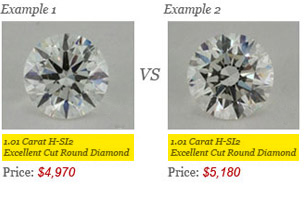
Why is a Grading Certificate Not Enough?
Take a look at the diamonds below. Both diamonds are 1.01 Carat H-SI2 Excellent Cut Round Diamonds. Based on price and certificate alone, these diamonds appear nearly identical. However, using our exclusive Diamond Display TechnologyTM, you can tell just how different these two diamonds are!
First, let’s look at the diamonds’ certificates:
A) 1.01 Carat H-SI2 Excellent Cut Round
Diamond
Click
to see the certificate
B) 1.01 Carat H-SI2 Excellent Cut Round
Diamond
Click to see the certificate
Based on certificate alone, which one would you choose?
Now, take a look at the actual diamonds:
A) 1.01 Carat H-SI2 Excellent Cut Round
Diamond
1.01 Carat H-SI2 Excellent Cut
Round
Diamond
Based on these actual diamond images, which diamond would you choose?
The diamond on the bottom (B) is eye-clean, the diamond on the top (A) is clearly not eye clean. That’s the power of seeing actual diamonds!
If you have any questions about a particular diamond, feel free to contact us. We have highly trained gemologists on staff available to assist you 24/7.
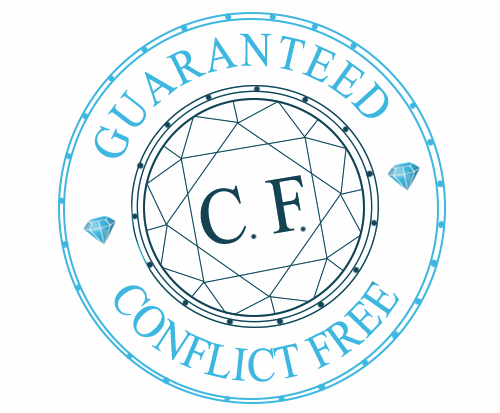
Conflict-Free Diamonds - Our Guarantee
At skc jewelry, we understand that our customers care where their diamonds come from, and we share that concern with you. Every diamond we sell is certified conflict-free in compliance with the Patriot Act, the Kimberley Process, and United Nations resolutions. Our internal guidelines exceed these government requirements: we have binding contracts with our suppliers which guarantee that the diamonds they offer to us for sale comply with all applicable laws and are certified conflict-free. We only purchase polished diamonds from sources which are members of the professional diamond trade.
Kimberley Process Compliance and America's Patriot Act
The Kimberley Process Certification Scheme (KPCS) was established by the United Nations General Assembly in 2003 to preclude diamonds associated with conflict from entering the diamond market. All KPCS Governments must certify that rough diamonds derive from sources known to be conflict-free. To extend the KPCS to polished diamonds, the World Diamond Council established a System of Warranties to guarantee that polished diamonds derive from a conflict-free rough source. Polished diamonds sold in the U.S. must adhere to the Patriot Act and sanctions by the US Treasury’s Office of Foreign Assets Control. Every U.S. dealer must maintain Kimberley compliance or be subject to penalties from Homeland Security, the U.S. Justice Department, and the U.S. Treasury.
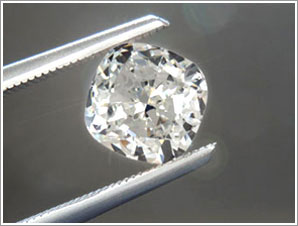
Eye Clean Diamonds
What Are Eye Clean Diamonds?
skc jewelry considers a diamond eye clean if it appears to be free of inclusions when viewed face up in daylight or fluorescent lighting by the naked eye from a relatively short distance (6-12 inches).
The concept of an eye clean diamond varies slightly in definition from retailer to retailer, but three major factors influence the definition of eye clean diamonds:
- Distance and point of reference
- The lighting under which the diamond is evaluated
- The vision of the viewer
According to GIA and AGS, diamonds that are considered Flawless (FL), Internally Flawless (IF), Very, Very Slightly Included (VVS1 and VVS2) and Very Slightly Included (VS1 and VS2) are considered eye clean. On the other hand, Slightly Included (SI1 and SI2) diamonds may or may not be eye clean. Included (I1, I2 and I3) diamonds are considered non eye clean.
skc jewelry utilizes the power of Artificial Intelligence (AI) and Deep Learning to uniquely analyze a diamond’s attributes. This revolutionary process is called Deep Grading™ and allows us to provide the most accurate assessment of whether a specific diamond is eye clean or not.
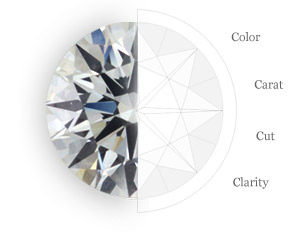
How to Choose the Perfect Diamond
When looking to buy a wedding or engagement ring, it is important that you know how to choose the perfect diamond. While some people prefer gemstone or rough diamonds, classic diamonds are still the most popular stone on the market and so it is essential that you understand everything you can about them. When searching for the perfect diamond*, there are four categories (or characteristics) to consider.
The 4 C's:
Cut - Describes the finish, proportion and polish of the diamond. These factors determine the fire and brilliance of a diamond.
An Ideal Cut diamond is a round (also known as brilliant) or princess cut diamond that is cut to ideal proportions and angles and has excellent polish and symmetry ratings.
A True Hearts diamond is a round or princess cut diamond that exhibits a near flawless Hearts and Arrows pattern of perfect optical symmetry, maximizing the diamond’s fire, brilliance and light dispersion.
Clarity - Describes the clearness or purity of a diamond. A grade is assigned to each diamond, with "F" representing a flawless diamond to "I" describing a diamond that has inclusions. Most diamonds can be found at various grades between “F” and “I.” Diamond buyers will sometimes choose a gem with some inclusions, as long as they are not visible to the naked eye.
Color - From white to yellow, diamonds receive a grade for the amount of color they contain. Diamond buyers prefer colorless to near colorless diamonds, with diamonds graded J, K, and L offering the best value for a customer’s money.
Carat - Carat refers to the weight of the diamond. One carat is equivalent to 0.20 grams. The larger the carat, the pricier the diamond, although the other "C's" can influence the final price significantly.
Though not mentioned as one of the four C's, a diamond's shape plays an integral part in the selection of any diamond engagement ring. skc jewelry offers diamonds in a variety of shapes, including: round, princess, emerald, square (asscher), oval, radiant, pear, heart, marquise and cushion shaped.
Lastly it is critical that you have a comprehensive understanding of diamond anatomy and proportion— brilliance, dispersion and scintillation.
Understanding how to choose the perfect diamond, will affect how you choose your engagement ring. Before choosing your perfect engagement ring, make sure you have a comprehensive understanding of diamonds- from their structure to the 4C's.
*To clarify, when we say perfect we are referring to the perfect diamond for you. This of course means that the diamond has the characteristics you desire and is within your budget. For example, some customers prefer larger diamonds with lower grades, while others prefer smaller diamonds with higher grades. Perfect diamonds— or diamonds without any flaws— are exceedingly rare and very expensive.
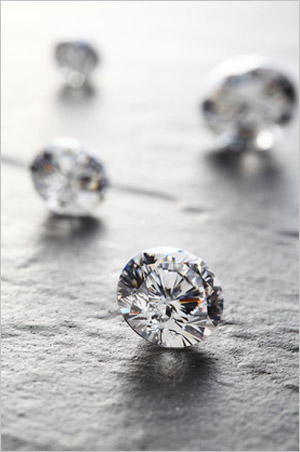
Diamond Care
Cleaning Your Diamond Jewelry
Depending on the setting you choose, you can soak your diamond engagement and/or wedding rings for up to 30 minutes in a solution of dishwashing liquid and water. This is best suited to prong and cathedral settings. In pave and basket settings, however, soaking the rings can increase the likelihood of the gems coming loose. Be mindful of this when you decide to soak any jewelry piece use mild dish soap in warm water and soak your jewelry for a few minutes. Using a soft cloth or cotton swab, gently scrub the metal (gold, platinum, silver) and then rinse. Repeat the process if necessary, but always proceed with caution when it comes to soaking jewelry.
For extra shine, you can soak diamonds in window cleaner afterwards. Because glass cleaner contains some harsh chemicals, do not soak for more than a minute at a time, and do not use this process at all with rhodium. To ensure that all of the glass cleaner is rinsed off, use the same mild dish soap solution. Dip your ring into the solution, rinse it with warm water, and then dry it completely.
You can use toothpicks to remove dirt that is lodged in between the prongs and the diamonds, but be extra careful not to scratch the metal or move the positioning of a prong. If fibers from cloth get stuck in the setting, gently use tweezers to remove them. Again, be careful of the metal. Even though diamonds can only be scratched by other diamonds, the precious metals into which they are set can be scratched more easily.
Ionic cleaners can be used on most diamond jewelry. If your engagement ring is set with stones other than diamonds, consider other cleaning methods, as some gemstones are adversely affected by the electrical current in the ionic cleaning process.
When storing your diamond jewelry, be sure to keep it separate from other jewelry. Remember that diamonds can not only scratch any other jewelry you have, but can scratch each other as well. Make sure that two diamond pieces are not being stored in such a way that they touch each other.
Insuring Your Diamond Jewelry
Once you have purchased your beautiful diamond jewelry, you will want to make sure that it is properly insured, in the event of theft or loss. Although homeowner's and renter's policies will cover a portion of your jewelry loss, it is often a small amount in comparison to the original cost of a diamond engagement ring or wedding ring. It is advisable to find out how much is covered by the policies you have in place, and then look into additional policies.
If you choose to get additional insurance, find out if there is a deductible and how much it is. Most insurance companies will not insure fine jewelry without an appraisal, so make sure you find out which appraisal reports are acceptable to your insurance company. Ask if the policy covers you fully, whether the item is merely damaged, or even if it is lost overseas. Many policies will have riders that do not allow for this level of coverage. Make sure you read the details of the policy carefully before you pay for extra insurance. Also find out if your jewelry is covered at the full replacement cost, and if you can receive a cash settlement in lieu of a replacement item.
Be aware that your insurance company may require updated appraisals on a regular basis. Be prepared to have your jewelry appraised every few years. Ask what the rules are for the particular insurance company you choose. Also find out if there is a discount if you have a home security system, such as an alarm system.
When you invest in diamond jewelry, you want to make sure that your investment is protected. Research insurance companies online or call around for information to make comparisons before you choose.

